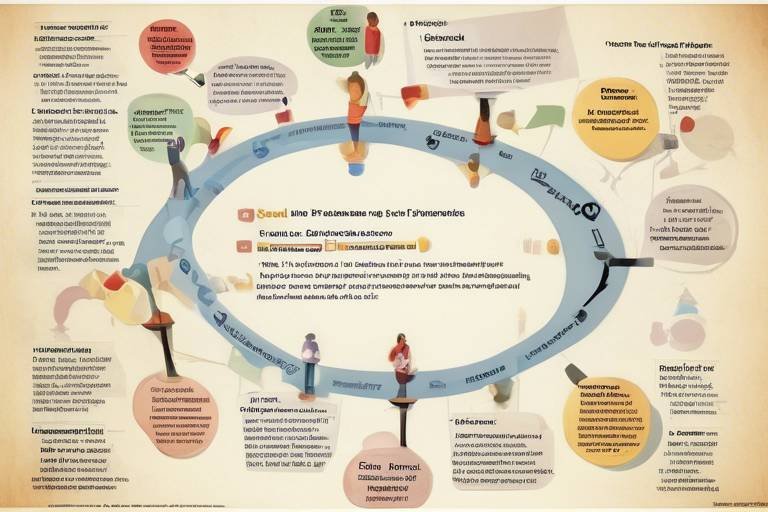The Role of Machine Learning in Predictive Analytics
In today's data-driven world, the intersection of machine learning and predictive analytics is nothing short of revolutionary. Imagine having the power to foresee future trends, consumer behavior, and potential risks just by analyzing past data. Sounds like magic, right? Well, it's not! This fascinating blend of technology is transforming industries and enhancing decision-making processes like never before. By leveraging complex algorithms and vast datasets, machine learning takes predictive analytics to the next level, providing businesses with insights that were once unimaginable.
So, what exactly is predictive analytics? At its core, it's about using historical data to make informed forecasts about future events. From predicting customer purchases to anticipating equipment failures, the applications are endless. Traditional analytics often relied on simpler statistical methods, but with the advent of machine learning, we can now analyze data in ways that are not only more sophisticated but also more accurate. This leads us to a new realm of possibilities where businesses can act proactively rather than reactively.
However, it's essential to understand that while machine learning significantly enhances predictive analytics, it also comes with its own set of challenges. For instance, the model's accuracy heavily depends on the quality of the data fed into it. Poor data can lead to misleading predictions, which could have dire consequences for businesses. Additionally, as algorithms become more complex, understanding how they arrive at specific predictions can become a daunting task. This is often referred to as the "black box" problem, where the decision-making process is not transparent.
Despite these challenges, the benefits of integrating machine learning into predictive analytics are profound. Organizations across various sectors, such as finance, healthcare, and retail, are witnessing improved accuracy in their forecasts. For instance, in finance, predictive analytics can help in risk assessment and fraud detection by identifying unusual patterns in transaction data. In healthcare, it can predict patient outcomes and optimize treatment plans based on historical patient data.
As we delve deeper into this article, we'll explore specific machine learning techniques that are pivotal in predictive analytics, such as regression analysis and classification algorithms. Each of these methods brings unique strengths to the table, allowing businesses to harness the full potential of their data. Moreover, we'll discuss the future trends in this exciting field and how organizations can prepare themselves to leverage these advancements.
- What is predictive analytics? Predictive analytics is the practice of using historical data to forecast future outcomes, helping businesses make informed decisions.
- How does machine learning enhance predictive analytics? Machine learning improves predictive analytics by identifying complex patterns in large datasets, leading to more accurate forecasts.
- What are some industries that benefit from predictive analytics? Industries such as finance, healthcare, retail, and marketing utilize predictive analytics to enhance their decision-making processes.
- What are the challenges of using machine learning in predictive analytics? Challenges include data quality issues, complexity of algorithms, and the "black box" nature of some machine learning models.

Understanding Predictive Analytics
Predictive analytics is like having a crystal ball that allows businesses to peek into the future. By leveraging historical data, organizations can forecast potential outcomes and trends, enabling them to make informed decisions. Imagine being able to predict customer behavior, market trends, or even potential risks before they occur! This capability is what makes predictive analytics a game-changer in today’s data-driven world.
At its core, predictive analytics utilizes various statistical techniques and algorithms to analyze past data and identify patterns. These patterns can then be used to create models that predict future events. Unlike traditional analytics, which often focuses on what has happened in the past, predictive analytics aims to answer the question, "What is likely to happen next?" This shift in focus is crucial for organizations that want to stay ahead of the competition.
The methodologies employed in predictive analytics can be quite diverse, ranging from simple linear regression to complex machine learning algorithms. Each method has its own strengths and weaknesses, making it essential for businesses to choose the right approach based on their specific needs. For instance, while regression analysis is excellent for understanding relationships between variables, classification algorithms are better suited for categorizing data into distinct groups.
One of the most significant advantages of predictive analytics is its ability to enhance decision-making processes. By providing insights into potential future scenarios, organizations can proactively adjust their strategies to mitigate risks or seize opportunities. For example, a retail company can use predictive analytics to forecast inventory needs, ensuring they have the right products at the right time, ultimately improving customer satisfaction.
However, it's essential to recognize that predictive analytics is not without its challenges. Data quality and availability are critical factors that can significantly impact the accuracy of predictions. If the historical data used is flawed or incomplete, the insights derived from it can lead to misguided decisions. Therefore, investing in robust data collection and management practices is crucial for organizations looking to harness the full potential of predictive analytics.
In summary, predictive analytics serves as a powerful tool that transforms raw data into actionable insights, allowing businesses to navigate the complexities of their industries with greater confidence. As we delve deeper into the various machine learning techniques that enhance predictive analytics, it becomes clear that understanding this field is not just beneficial, but essential for success in the modern marketplace.

Machine Learning Techniques in Predictive Analytics
When it comes to predictive analytics, machine learning techniques are like the secret sauce that takes your data from ordinary to extraordinary. They empower businesses to sift through mountains of data and extract valuable insights that can guide decision-making. But what exactly are these techniques, and how do they work? Let's dive in!
At the core of predictive analytics, machine learning techniques can be broadly categorized into three main types: regression, classification, and clustering. Each of these techniques serves a unique purpose and comes with its own set of tools and algorithms. Understanding these can help you leverage the power of machine learning effectively.
Regression techniques are primarily used for predicting continuous outcomes. Imagine trying to forecast the sales of a product based on historical data; regression analysis helps you draw a line of best fit through your data points to predict future sales. It's like trying to predict the weather based on past patterns—if it rained last year on this date, there's a good chance it might rain again this year!
On the other hand, classification algorithms are all about categorizing data into predefined classes. Think of it as sorting your laundry; you have whites, colors, and delicates. Similarly, classification helps businesses categorize customer behaviors, such as whether a customer is likely to buy a product or not. Popular algorithms like Decision Trees, Random Forest, and Support Vector Machines (SVM) are commonly used in this space. They take your data and help you make informed decisions based on the categories that emerge.
Lastly, we have clustering, which is a bit different from the previous two. Instead of predicting a specific outcome, clustering algorithms group similar data points together. It's like organizing a party guest list; you group people based on their interests or backgrounds. In predictive analytics, clustering can help identify customer segments, allowing businesses to tailor their marketing strategies effectively.
To summarize, here's a quick look at the three main machine learning techniques used in predictive analytics:
| Technique | Description | Common Applications |
|---|---|---|
| Regression | Predicts continuous outcomes based on historical data. | Sales forecasting, real estate pricing |
| Classification | Categorizes data into predefined classes. | Spam detection, customer segmentation |
| Clustering | Groups similar data points without predefined labels. | Market segmentation, social network analysis |
These machine learning techniques are not just theoretical; they have real-world applications across various industries, from finance to healthcare. By harnessing the power of these techniques, businesses can make data-driven decisions that enhance operational efficiency and drive growth. So, whether you're predicting customer behavior or optimizing supply chains, machine learning is the key to unlocking the future of predictive analytics!
- What is predictive analytics?
Predictive analytics is the practice of using historical data to forecast future outcomes, helping businesses make informed decisions. - How does machine learning improve predictive analytics?
Machine learning enhances predictive analytics by identifying complex patterns in large datasets, leading to more accurate predictions. - What are the main techniques used in predictive analytics?
The main techniques include regression, classification, and clustering, each serving a unique purpose in data analysis.

Regression Analysis
Regression analysis is a cornerstone of predictive modeling, acting as a powerful tool that helps us understand relationships between variables and forecast future outcomes. Imagine trying to predict the score of a basketball game based on the players' past performances; regression analysis allows us to draw insights from historical data to make educated guesses about what might happen next. It’s like having a crystal ball, but instead of magic, it relies on statistical techniques to uncover patterns and trends.
There are several types of regression analysis, each serving its unique purpose. The most commonly used types include linear regression and logistic regression. While linear regression deals with continuous outcomes, logistic regression is tailored for binary outcomes—think of it as a way to predict yes or no scenarios. By utilizing these techniques, businesses can tailor their strategies based on data-driven insights.
One of the most significant advantages of regression analysis is its ability to quantify relationships. For instance, a retail company might use regression to analyze how various factors like advertising spend, seasonality, and economic indicators influence sales. By establishing a regression model, they can determine which factors have the most substantial impact and optimize their marketing strategies accordingly.
However, regression analysis is not without its challenges. One must be cautious of overfitting, where a model becomes too complex and starts to capture noise rather than the underlying trend. This can lead to poor predictions when applied to new data. Additionally, the assumptions behind regression techniques, such as linearity and homoscedasticity, must be checked to ensure the model's validity.
To illustrate the power of regression analysis, consider the following table that summarizes the types of regression and their applications:
| Type of Regression | Description | Common Applications |
|---|---|---|
| Linear Regression | Predicts continuous outcomes based on linear relationships. | Sales forecasting, real estate pricing, and risk assessment. |
| Logistic Regression | Used for binary outcomes, predicting probabilities of categorical outcomes. | Spam detection, disease diagnosis, and customer churn prediction. |
| Polynomial Regression | Models relationships as an nth degree polynomial. | Complex trend analysis in sales data and environmental modeling. |
In summary, regression analysis is an essential technique in the arsenal of predictive analytics, enabling organizations to make informed decisions based on historical data. By understanding the relationships between different variables, businesses can not only enhance their forecasting abilities but also improve their overall strategic planning.

Linear Regression
Linear regression is a fundamental technique in predictive modeling that serves as a stepping stone for many aspiring data scientists. Think of it as the compass guiding you through the vast forest of data. At its core, linear regression seeks to establish a relationship between a dependent variable (the outcome you want to predict) and one or more independent variables (the factors you believe influence that outcome). This relationship is represented as a straight line in a two-dimensional space, making it easy to visualize and interpret.
The beauty of linear regression lies in its simplicity and effectiveness. It’s like the Swiss Army knife of predictive analytics—versatile and handy in various scenarios. For instance, businesses can use linear regression to predict sales based on advertising spend, or healthcare professionals might analyze how patient age and lifestyle factors influence blood pressure levels. The formula for linear regression can be succinctly expressed as:
Y β0 + β1X1 + β2X2 + ... + βnXn + ε
Where:
- Y Dependent variable (what you are trying to predict)
- β0 Intercept (the value of Y when all X's are 0)
- β1, β2, ..., βn Coefficients (the change in Y for a one-unit change in X)
- X1, X2, ..., Xn Independent variables (the predictors)
- ε Error term (the difference between the predicted and actual values)
While linear regression is powerful, it does come with its limitations. For one, it assumes that the relationship between the variables is linear, which might not always be the case. If the data exhibits a more complex relationship, relying solely on linear regression can lead to inaccurate predictions. Moreover, outliers can significantly skew results, making it crucial to preprocess data adequately before applying this technique.
In practice, linear regression is often used in various fields, including finance for stock price predictions, marketing for customer behavior analysis, and even in environmental science to understand how different factors influence climate change. Its accessibility and interpretability make it an ideal starting point for those diving into the world of predictive analytics.
In conclusion, linear regression is not just a statistical method; it’s a way to unlock insights hidden within data. By establishing clear relationships between variables, it empowers decision-makers to forecast future trends and make informed choices. As you embark on your predictive analytics journey, mastering linear regression will undoubtedly serve as a valuable asset in your analytical toolkit.

Logistic Regression
Logistic regression is a powerful statistical method used for predicting binary outcomes, such as yes/no or success/failure scenarios. Unlike linear regression, which predicts continuous outcomes, logistic regression is specifically designed to handle situations where the response variable is categorical. This makes it an essential tool in the realm of predictive analytics, especially in industries like healthcare, finance, and marketing.
At its core, logistic regression estimates the probability that a given input point belongs to a particular category. It does this by applying the logistic function, which transforms any real-valued number into a value between 0 and 1. This transformation is crucial because it allows the model to output probabilities that can be interpreted as the likelihood of belonging to a certain class. For instance, in a medical diagnosis scenario, a logistic regression model might output a probability of 0.85 for a patient having a specific disease, which can be interpreted as an 85% chance of the patient being diagnosed positively.
One of the key advantages of logistic regression is its simplicity and interpretability. The coefficients obtained from the model can be easily understood and provide insights into how different features affect the outcome. For example, in a marketing campaign analysis, the model might show that an increase in customer age is associated with a higher probability of purchasing a product. This interpretability is vital for stakeholders who need to make informed decisions based on the model's predictions.
However, logistic regression is not without its limitations. One major challenge is that it assumes a linear relationship between the independent variables and the log odds of the dependent variable. If the actual relationship is more complex, logistic regression may not perform well. Additionally, it is sensitive to outliers, which can skew the results and lead to inaccurate predictions. Therefore, it is essential to preprocess the data carefully and consider alternative modeling techniques if the assumptions of logistic regression do not hold.
In practice, logistic regression is often implemented using software tools that allow analysts to input their data and receive predictions with minimal effort. The output can be visualized using confusion matrices, which display the performance of the model by comparing predicted outcomes against actual results. This visualization helps in understanding the model's effectiveness and in making necessary adjustments to improve accuracy.
In summary, logistic regression serves as a fundamental technique in predictive analytics for binary classification tasks. Its ability to provide probabilistic interpretations, combined with its straightforward implementation, makes it a go-to choice for many analysts. However, like any other model, it requires careful consideration of its assumptions and limitations to ensure that it delivers reliable predictions.
- What is logistic regression used for?
Logistic regression is primarily used for predicting binary outcomes, such as whether an email is spam or not, or whether a patient has a certain disease. - How does logistic regression differ from linear regression?
While linear regression predicts continuous outcomes, logistic regression predicts probabilities for categorical outcomes, specifically binary classifications. - What are the assumptions of logistic regression?
Logistic regression assumes a linear relationship between the independent variables and the log odds of the dependent variable, and it also requires that the observations are independent. - Can logistic regression handle multiple independent variables?
Yes, logistic regression can handle multiple independent variables, making it suitable for complex models involving various predictors.

Classification Algorithms
Classification algorithms are the backbone of predictive analytics, enabling businesses to categorize data into predefined classes. Imagine you’re a doctor trying to diagnose a patient based on symptoms. You wouldn’t just throw darts at a board to guess the illness, right? Instead, you’d rely on a systematic approach to classify the symptoms into a diagnosis. This is precisely what classification algorithms do—they analyze input data and assign it to specific categories based on learned patterns.
There are several popular classification algorithms, each with its unique strengths and applications. For instance, Decision Trees are intuitive and easy to interpret, making them great for visualizing decision-making processes. On the other hand, Support Vector Machines (SVM) excel in high-dimensional spaces, making them perfect for complex datasets. Then we have Random Forests, which aggregate multiple decision trees to improve accuracy and reduce the risk of overfitting. Here’s a quick overview of some widely used classification algorithms:
| Algorithm | Description | Best Use Case |
|---|---|---|
| Decision Trees | Model that splits data into branches to make decisions. | Customer segmentation, risk assessment. |
| Support Vector Machines (SVM) | Finds the hyperplane that best separates data into classes. | Image classification, text categorization. |
| Random Forests | An ensemble method that combines multiple decision trees. | Fraud detection, medical diagnosis. |
| K-Nearest Neighbors (KNN) | Classifies based on the majority class of nearest neighbors. | Recommender systems, anomaly detection. |
Classification algorithms not only help in making accurate predictions but also provide insights that can drive strategic decisions. For instance, in the retail industry, these algorithms can analyze customer purchase history and classify customers into segments, enabling targeted marketing campaigns. This targeted approach not only increases customer satisfaction but also boosts sales. Isn't it fascinating how a few lines of code can lead to such impactful outcomes?
Moreover, the ability to handle large datasets makes classification algorithms indispensable in today’s data-driven world. With the rapid growth of data, businesses need tools that can efficiently process and categorize information. This is where machine learning shines—by continuously learning from new data, these algorithms improve over time, becoming more accurate and reliable.
However, it’s essential to recognize that classification algorithms are not a one-size-fits-all solution. The choice of algorithm depends on various factors, including the nature of the data, the specific problem at hand, and the desired outcome. Understanding these nuances is crucial for leveraging the full potential of predictive analytics in your organization.
- What is the main purpose of classification algorithms?
Classification algorithms are used to categorize data into predefined classes, enabling businesses to make informed decisions based on predictive analytics. - How do I choose the right classification algorithm?
The choice of algorithm depends on the nature of your data, the complexity of the problem, and the specific outcomes you want to achieve. Experimenting with different algorithms can help identify the best fit. - Can classification algorithms handle large datasets?
Yes, many classification algorithms, especially those based on machine learning, are designed to efficiently process and analyze large datasets.

Benefits of Machine Learning in Predictive Analytics
In the rapidly evolving landscape of data analytics, machine learning stands out as a transformative force, particularly in the realm of predictive analytics. The integration of machine learning techniques allows businesses to leverage vast amounts of data, uncovering insights that were previously hidden. But what exactly are the benefits of using machine learning in predictive analytics? Let's dive into this exciting topic.
One of the most significant advantages is improved accuracy. Traditional predictive models often rely on simplistic assumptions and linear relationships, which can lead to inaccurate forecasts. In contrast, machine learning algorithms are designed to learn from data. They can identify complex patterns and relationships that would be impossible for humans to detect. This capability not only enhances the accuracy of predictions but also builds a more robust foundation for decision-making.
Moreover, the ability to process real-time data is a game-changer in today's fast-paced business environment. Machine learning algorithms can analyze data as it comes in, providing organizations with timely insights. This means businesses can react proactively to emerging trends or potential issues, rather than waiting for periodic reports. For instance, in industries like finance, where market conditions can change in seconds, having real-time predictive analytics can be the difference between profit and loss.
Additionally, machine learning contributes to increased efficiency in predictive analytics. By automating the data analysis process, organizations can save time and allocate resources more effectively. This efficiency allows teams to focus on interpreting the results and making strategic decisions rather than getting bogged down in data preparation and analysis. For example, in healthcare, predictive analytics powered by machine learning can streamline patient care by predicting potential health risks, enabling proactive interventions.
Another noteworthy benefit is the ability to handle large datasets. As the volume of data generated by businesses continues to grow exponentially, traditional analytics tools struggle to keep pace. Machine learning algorithms excel in processing vast amounts of data quickly and accurately. This capability opens up new possibilities for industries such as e-commerce, where analyzing customer behavior across millions of transactions can lead to personalized shopping experiences and targeted marketing strategies.
Furthermore, the adaptability of machine learning models is a crucial factor in their effectiveness. Unlike static models, machine learning algorithms can continuously learn and improve over time. This means that as new data becomes available, the models can adjust their predictions accordingly. This adaptability is particularly valuable in dynamic environments, such as supply chain management, where demand can fluctuate based on various factors.
In summary, the benefits of integrating machine learning into predictive analytics are profound. From improved accuracy and real-time data processing to increased efficiency and the ability to handle large datasets, machine learning is revolutionizing how businesses make data-driven decisions. As we continue to explore this intersection of technology and analytics, the potential for innovation is limitless.
- What is predictive analytics? Predictive analytics involves using historical data to forecast future outcomes, helping organizations make informed decisions.
- How does machine learning improve predictive analytics? Machine learning enhances predictive analytics by identifying complex patterns in data that traditional methods may overlook, leading to more accurate predictions.
- Can machine learning handle real-time data? Yes, machine learning algorithms can analyze real-time data, allowing businesses to gain timely insights and make proactive decisions.
- What industries benefit from predictive analytics? Industries such as finance, healthcare, e-commerce, and supply chain management significantly benefit from predictive analytics powered by machine learning.

Improved Accuracy
One of the most compelling advantages of incorporating machine learning into predictive analytics is the significant boost in accuracy it provides. Traditional methods often rely on simplistic models that may overlook complex patterns within the data. In contrast, machine learning algorithms can sift through vast amounts of data, identifying intricate relationships that humans might miss. This capability not only enhances the quality of predictions but also allows businesses to make more informed decisions based on reliable insights.
Imagine you’re trying to forecast sales for a retail store. Using traditional analytics, you might look at past sales data and seasonal trends. However, machine learning can analyze numerous factors—such as weather patterns, local events, and even social media sentiment—to create a much more nuanced prediction. The ability to integrate diverse data sources means that predictions become more robust and reliable.
To illustrate this point, consider the following table that compares traditional analytics with machine learning-enhanced predictive analytics:
| Aspect | Traditional Analytics | Machine Learning Analytics |
|---|---|---|
| Data Handling | Limited to structured data | Handles both structured and unstructured data |
| Pattern Recognition | Basic trend analysis | Advanced pattern detection |
| Adaptability | Static models | Dynamic models that learn from new data |
| Prediction Accuracy | Moderate accuracy | High accuracy with continuous improvement |
Moreover, machine learning algorithms continuously improve over time. As they process more data, they refine their models, leading to even greater accuracy in predictions. This is particularly beneficial in industries like finance and healthcare, where precision is paramount. For example, in finance, accurate predictions can mean the difference between profit and loss, while in healthcare, they can lead to better patient outcomes.
Additionally, the enhanced accuracy provided by machine learning can significantly reduce risks. Businesses can identify potential issues before they escalate, allowing for proactive measures rather than reactive fixes. With the right predictive models, companies can anticipate market changes, customer behaviors, and operational challenges, leading to a more strategic approach in their decision-making processes.
In conclusion, the improved accuracy offered by machine learning in predictive analytics is not just a minor enhancement; it’s a game changer. By leveraging advanced algorithms that learn and adapt, organizations can gain insights that drive success and foster growth. As we move forward, the integration of machine learning into predictive analytics will undoubtedly reshape how businesses operate, making data-driven decision-making more accurate and effective than ever before.
- What is predictive analytics? Predictive analytics uses historical data to forecast future outcomes, helping organizations make informed decisions.
- How does machine learning improve predictive analytics? Machine learning enhances predictive analytics by identifying complex patterns in large datasets, leading to more accurate predictions.
- What industries benefit most from predictive analytics? Industries like finance, healthcare, retail, and marketing significantly benefit from improved predictive capabilities.
- Can machine learning models adapt over time? Yes, machine learning models continuously learn from new data, improving their accuracy and effectiveness.

Real-time Data Processing
In today's fast-paced world, the ability to process data in real-time is nothing short of revolutionary. Imagine you're a pilot flying a plane; you wouldn't want to rely on outdated weather reports, right? Similarly, businesses today need real-time insights to navigate the turbulent skies of the market. Machine learning facilitates this by enabling organizations to analyze incoming data streams instantly, allowing for rapid decision-making that can significantly impact their bottom line.
One of the standout features of machine learning in real-time data processing is its capacity to handle vast amounts of data with incredible speed and accuracy. For instance, consider a financial institution monitoring transactions for fraudulent activity. By employing machine learning algorithms, they can analyze thousands of transactions per second, flagging any suspicious behavior almost instantaneously. This not only enhances security but also builds trust with customers who know their transactions are being monitored effectively.
The implications of real-time data processing extend beyond just fraud detection. In sectors like healthcare, machine learning can analyze patient data as it comes in, providing doctors with timely alerts about critical changes in a patient's condition. This can be a matter of life and death, showcasing how vital real-time analytics can be. Moreover, in the realm of e-commerce, businesses can adjust their marketing strategies on-the-fly based on customer behavior and preferences, leading to higher conversion rates and improved customer satisfaction.
However, while the benefits are compelling, implementing real-time data processing is not without its challenges. Organizations must invest in robust infrastructure capable of handling the constant influx of data. Additionally, they need to ensure that their machine learning models are not only accurate but also capable of adapting to new patterns as they emerge. This dynamic nature of data requires a commitment to continuous learning and improvement.
In summary, the integration of machine learning into real-time data processing is transforming how businesses operate. It empowers them to make informed decisions quickly, respond to market changes proactively, and ultimately gain a competitive edge. As technology continues to evolve, we can expect even more innovative applications of real-time analytics, making it an exciting area to watch.
- What is real-time data processing? Real-time data processing refers to the immediate processing and analysis of data as it is generated, allowing for quick decision-making.
- How does machine learning enhance real-time data processing? Machine learning algorithms can analyze large volumes of data quickly, identifying patterns and anomalies in real-time.
- What industries benefit from real-time data processing? Industries such as finance, healthcare, e-commerce, and logistics greatly benefit from real-time data processing for improved decision-making and efficiency.
- What are the challenges of implementing real-time data processing? Challenges include the need for robust infrastructure, continuous model updates, and ensuring data accuracy and security.
Frequently Asked Questions
-
What is predictive analytics?
Predictive analytics is a method that uses historical data to forecast future outcomes. It's like looking into a crystal ball, but instead of magic, it relies on data patterns and statistical algorithms to make educated guesses about what might happen next.
-
How does machine learning enhance predictive analytics?
Machine learning boosts predictive analytics by identifying complex patterns in large datasets that traditional methods might miss. Think of it as having a super-smart assistant who can sift through mountains of data and highlight the most important trends and insights for you!
-
What are some common machine learning techniques used in predictive analytics?
Common techniques include regression analysis, classification algorithms, and clustering. Each technique serves a unique purpose, helping to categorize data, predict outcomes, or group similar data points together, much like sorting your laundry into colors and whites!
-
What is the difference between linear and logistic regression?
Linear regression is used for predicting continuous outcomes, like sales revenue, while logistic regression is used for binary outcomes, such as yes/no decisions. It's like comparing a speedometer (linear) to a traffic light (logistic) – both are useful, but for different situations!
-
What are the benefits of using machine learning in predictive analytics?
Machine learning provides improved accuracy, efficiency, and the ability to process vast amounts of data quickly. This means businesses can make better decisions faster, just like having a GPS that not only tells you where to go but also avoids traffic jams!
-
How does real-time data processing impact decision-making?
Real-time data processing allows businesses to react promptly to changes and trends, leading to proactive decision-making. Imagine being able to adjust your plans on the fly, like a chef who tweaks a recipe based on customer feedback right at the dinner rush!
-
What industries can benefit from predictive analytics?
Predictive analytics can benefit a wide range of industries, including finance, healthcare, retail, and manufacturing. It's like having a secret weapon that helps companies anticipate customer needs, manage risks, and optimize operations across various sectors!



















